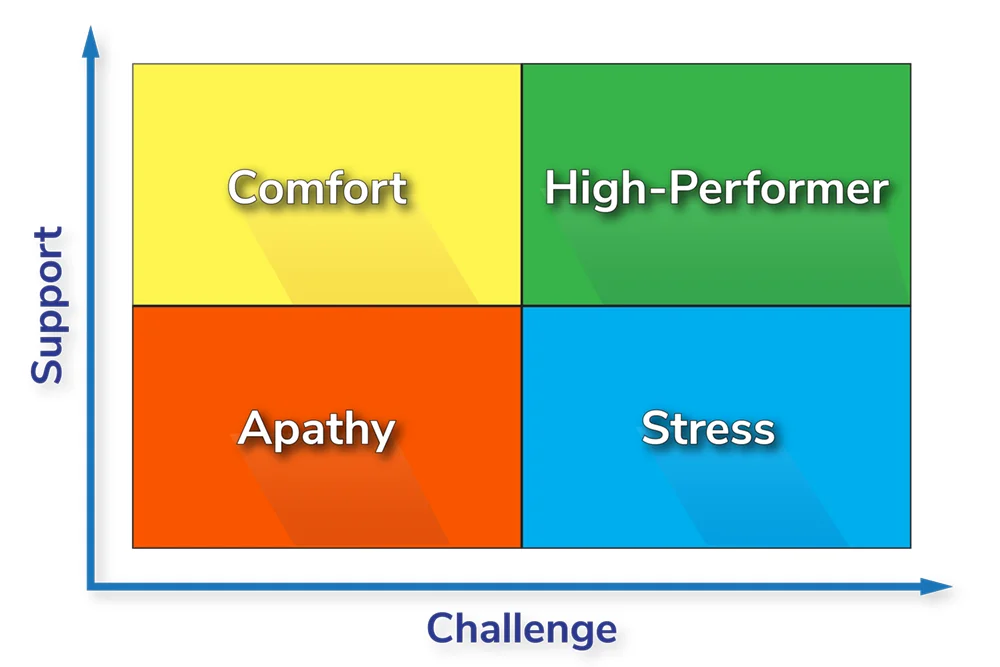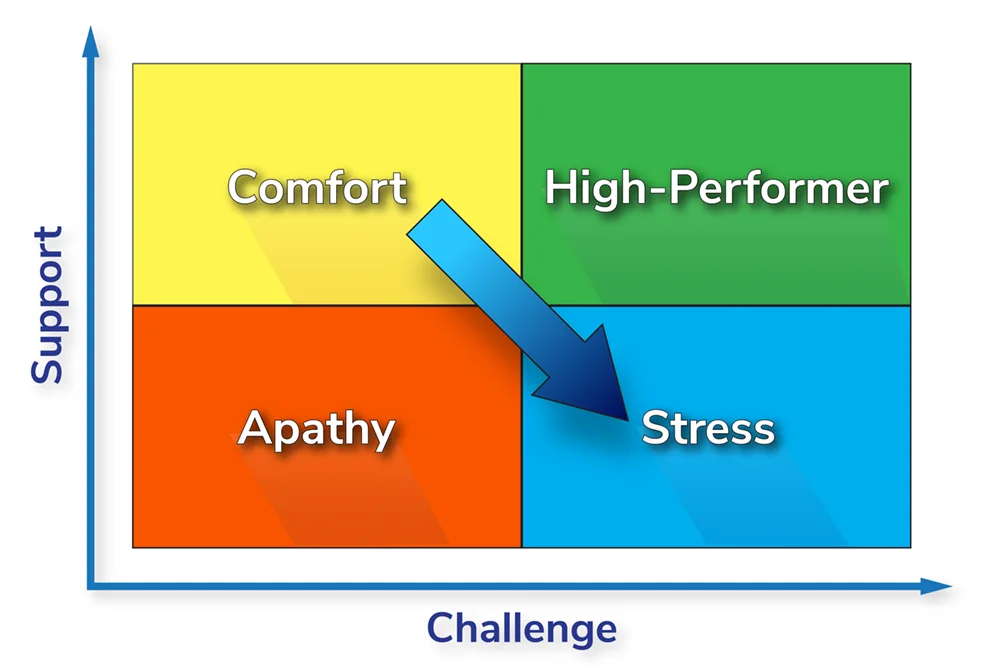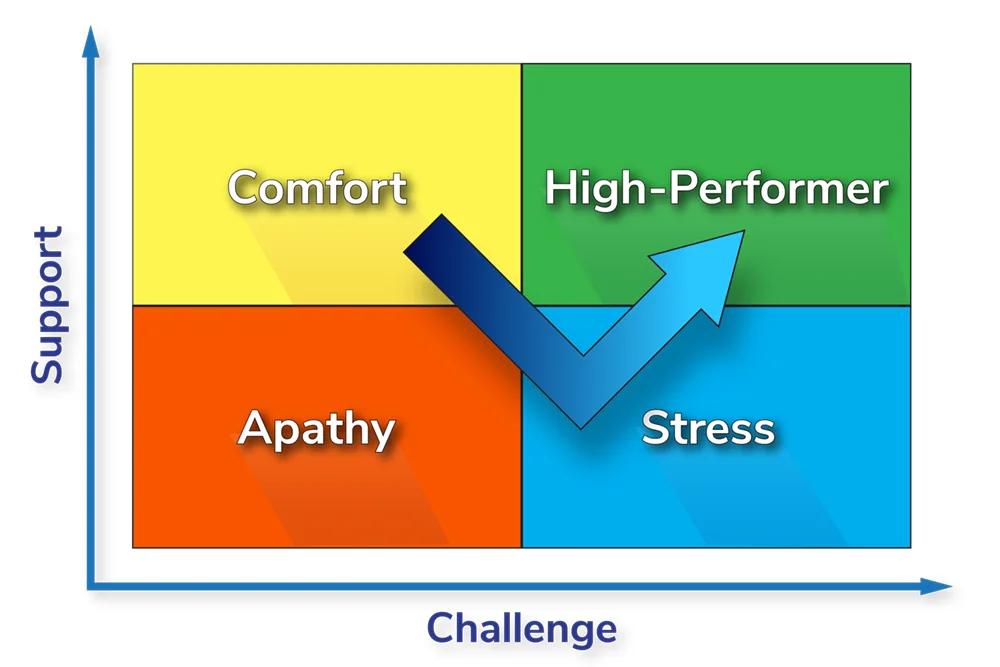
Authors Kevin Sabany and Saul Bautista
We’ve implemented a simple, two-step approach to help organizations develop the spark in their team leaders to turn them into high performers.
Our team engages with many organizations across many industries. A fairly common business objective we’ve encountered is the desire to ‘develop the organization’ somewhere embedded in its goals or mission statement. This goal usually means developing the organization’s leaders to drive progress and improvement.
However, only some organizations understand how to create the catalyst necessary for their team members to grow into the capable leaders they would like them to be.
We’ve implemented a simple, two-step approach to help organizations develop the spark in their team leaders to turn them into high performers. We will call it ‘V of the High-Performance Victory.’
First, let’s examine the four modes, or states, we typically find in employees based on our experience with the four quadrants of the Support and Challenge theory.

Comfort Zone
We often call this mode the ‘good job’ zone. But unfortunately, this is a danger zone for employees and is common across many organizations. The key indicator of this state is when managers and supervisors continuously praise the team, generating a comfort and camaraderie status. This seemingly positive behavior can create a non-challenging environment where everybody knows what to do during the day, and there is no need to follow up on specific performance.
However, not knowing working standards, assigning workloads, or following up on performance creates a lack of definition. Leaders then believe that simply connecting with their direct reports to ensure they are ‘OK’ is how to supervise the organization properly.
Most supervisors then walk their area ‘to see and be seen’ and toss out ‘good job’ praise across their organization. These repeated touches with no purpose can create a hole in the Comfort Zone that can inevitably have the leaders falling into the Apathy Zone.
Apathy Zone
We refer to this mode as the ‘no-trust zone.’ This zone refers to a state of mind where a team member is indifferent or lacks enthusiasm and motivation. Essentially, they are completely disengaged from their job, their performance, and the purpose of the business.
Workforce members caught in the Apathy Zone may feel disconnected from their passion, goals, and relationships. They might struggle to get excited about anything, resulting in a lack of energy and creativity. Many factors, such as burnout, stress, depression, or a lack of purpose, can cause this state.
The Apathy Zone can also be a vicious cycle, as being in this state can make it even harder to find the motivation to break out. Therefore, a leader must develop a solid support system to ensure employees find healthy coping mechanisms and reignite their passion and drive.
Stress Zone
This condition is the zone of ‘many questions.’ The Stress Zone in the Support and Challenge model refers to the difficulty or demand level placed on an individual that falls between their current skill level and their potential.
Learning and growth occur in this zone, requiring individuals to stretch their abilities and acquire new skills. However, too much stress can lead to overwhelming and adverse outcomes, while too little stress can result in boredom and lack of motivation.
Therefore, the Support and Challenge model emphasizes the importance of providing adequate support and guidance to individuals in the stress zone to help them navigate and overcome the challenges they face while ensuring their well-being and success.
High Performer Zone
The high-performer zone refers to the level of challenge that falls within an individual’s potential and exceeds their current skill level. High levels of performance, mastery, and achievement characterize this zone.
Individuals in the high-performer zone experience a sense of flow and engagement as they are fully immersed in their activities and clearly understand progress and accomplishment.
However, to maintain high performance over time, individuals must also receive adequate support and resources, such as feedback, recognition, and opportunities for growth and development.
In addition, it is critical for high-performing individuals to periodically challenge themselves by setting new goals and pursuing new opportunities. By setting the bar a little higher, managers can help these valuable team members avoid complacency and continue to stretch their abilities.
But, most importantly, it can help them avoid falling back into the Comfort Zone once the newly acquired skills are implemented and the performance improvements occur continually.
Two Steps to Victory – The ‘V Process’ for High Performance Victory
The pathway to developing high-performing leaders requires this two-step approach. We call it the ‘V Process’ for building high performers with intention and purpose. It’s a sure-fire pathway to engage and develop your teams’ leadership abilities, increase overall productivity, improve workplace culture, and drive bottom line performance.
Step 1Moving People from the Comfort Zone to the Stress Zone
While continuously connecting with the team is paramount for the ‘V Process’ to work effectively (and is the first stage to interact with the organization, as mentioned previously), the team member touchpoints and interactions require a structure and approach that defines progress.
How are they doing with the assigned job? Did they complete the task in the allotted time? Assigning aggressive but achievable tasks is one of the most critical actions leaders must take to support team members’ effective transitions from the Comfort Zone, through the Stress Zone, on their way to becoming high performers.


Step 2Supporting Team Members Through the Stress Zone into High-Performer Zone
Organizational leaders must add support to move individual team members of the Stress Zone up to the High-Performer Zone. This essential ingredient involves offering help to understand the task at hand.
However, it is critical to understand that most people feel anxiety when pushed out of their comfort zone. Therefore, higher-up managers and supervisors need to recognize when stress affects an individual’s performance and take steps to manage it.
More repetitions or connections will be required when a team member is in the Stress Zone to help them avoid confusion or giving up. With a good support approach, managers offer solutions or alternatives to help team members tackle new challenges. This support can help the individual’s decision-making and execute the task more successfully.
Our Final Thoughts on the V Process
Organizational leaders need to understand that this two-step process is unavoidable. You cannot move an individual team member, nor an entire workforce, from the Comfort Zone directly to the High-Performer zone.
When leaders believe this is possible, they merely assign tasks that are not challenging to the individual. These tasks will not push the individual out of their comfort zone and do not generate some level of stress. Therefore, they will not cause actual development, and the process will not yield a high-performing individual.
Leaders need to identify challenging initiatives to gauge their team’s stress level. Only then can they agree to be on a path to develop high-performer team members.
The POWERS Difference
POWERS is deeply experienced in making the two-step leadership development process efficient, productive, scalable, and sustainable across your organization. POWERS will create assessment tools to help your company identify skill gaps and developmental needs and create a plan to address them.
In addition, our team will provide one-on-one and group coaching sessions to drive immediate and long-term success. By partnering with POWERS to improve employee productivity and build stronger leaders, your company can drive performance that improves the bottom line.
At POWERS, we focus on Frontline Leadership Training and Development to transform operational performance and prepare your leaders to be better change managers. We help you build a growth and performance culture that operates at peak levels to lower costs, increase productivity, build agility, and sustain that performance over the long haul.
Our team has helped executive leadership across many industries operationalize their culture for rapid and sustained performance improvement, increased competitive advantage, greater value, and a stronger bottom line.
To put our experienced team and proven track record to work for you, schedule an initial discovery and analysis by calling +1 678-971-4711, or emailing us at info@thepowerscompany.com.



